Problem No. 120 from Igo Hatsuyoron
By Inoue Dosetsu Inseki (1646 - 1719)
 Black to play and win |
 |
 Black to play and win |
 |

|
This website has grown over time with every step of our investigations, so it may now appear a bit too complex, and its overall structure too difficult to see. But a general re-design would cost too much effort and time. So we decided to add a summary with the highlights and key-results of our research as well as to have each chapter on a separate page. We provide a historical outline of the changes. |
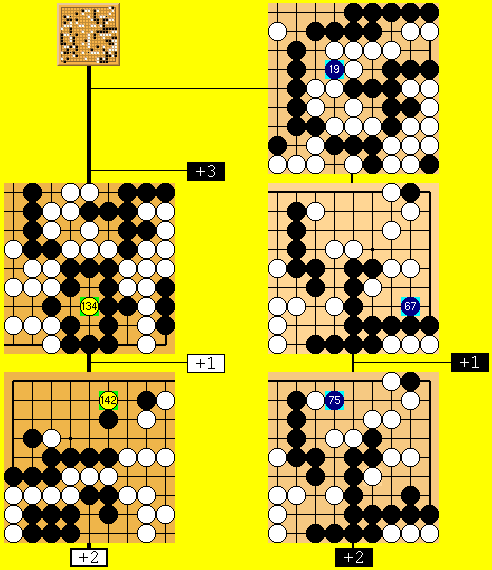 |
| The picture above shows the key-moves we had found. Those on the left side (White 134 and 142 - White wins !) are professionally approved. Only a few variations after the moves on the right (especially Black 67) have been professionally checked so far. |
| 2005 | Joachim's Oki wins the problem for White. |
| 2007 | Yamada Shinji's Tsuke gains another point for White. The 2nd Throw-in seems to be possible. My Guzumi wins the problem back for Black. |
| 2008 | Two paths after the Guzumi. |
| 2009 | Another path after the Guzumi. Harry's Hasami-Tsuke gains another point for Black. The Guzumi is not possible any more after the Crosscut sequence. |
| 2010 | The variation-tree after the Guzumi is born. If White forces Black to make two eyes in the upper right. If Black captures the entire left side. |
| 2011 | The correct order of moves in the top right corner after White 66. Yamada's Tsuke in the upper left is always possible, when following the Main Path. Q16 would be better for White than N13, when following the Main Path after the Guzumi. The variation-tree after Black's Guzumi 67. About the reduction of White's top right corner. Our current solution. The Guzumi gives options back to Black. A new type of Seki. Partial Validation Through Professional Chinese Research. |

|
Inhalt: Joachim's Oki wins the problem for White. |

|
Joachim's Oki wins the problem for White. |
|
 Dia. 05.1: "Joachim's Placement with W 134" |
The German Go-Journal (DGoZ) reports on what Joachim Meinhardt had found: White can win by throwing-in with 134. Compared to the "official" solution Black loses one stone ... |
 Dia. 05.2: "The End of the 'Official' Solution" |
... and three points of territory, which changes a 3-point-win for Black into a 1-point-win for White ! [ to the sequence ] STATUS: Joachim's move as strongest White resistance has been proven true by professionals ! |

| |

|
Content: Yamada Shinji's Tsuke gains another point for White. The 2nd Throw-in seems to be possible. My Guzumi wins the problem back for Black. |

|
Yamada Shinji's Tsuke gains another point for White. |
|
 Dia. 07.1: "Yamada Shinji's Tsuke and the 'Usual' Atari" |
Yamada Shinji 4p is busy with the problem during a stay in Korea (many thanks to Benjamin Teuber 6d). Because the White group on the left side now certainly lives, the Tsuke (attachment) of 142 becomes possible. It gives White another 1-point advantage compared to the "official" solution. Results in White +2. [ to the sequence ] Update 2011: Yamada's Tsuke can be played earlier, too, as can be seen [ here. ] |

| |
The 2nd Throw-in seems to be possible. |
|
 Dia. 07.2: "The Second Throw-in with B 19" |
In Germany two amateur Kyu-players (Joachim and me) ask why it is not be possible to Throw-in for the second time with Black 19 during the opening sequence of the problem. We cannot find the Semeai that is mentioned in the sources, and that is supposed to be harmful for Black. This Throw-in has advantages as well as disadvantages. If the Seki in the lower right is dissolved, then Black's lost stone (at 19) is over-compensated for by an extra white stone (at 20), but Black has removed an extra liberty from the White stones at centre right. If the Seki remains, however, the second Throw-in becomes a lost point. If Black's group in the top right is taken off the board, Black will gain an advantage of two points, because he is not forced anymore to sacrifice an additional stone. [ to the sequence ] [ to the explanation ] To provide a clear distinction between our work and the "official" solution, all our amateurs' attempts will be shown after this second Throw-in. Update 2011: Cheng Xiaoliu 6p used the second Throw-in in his 2010 book "Research on Weiqi Fayanglun". |

| |
My Guzumi wins the problem back for Black. |
|
 Dia. 07.3: "My Idea for 'Bad Shape'" |
At the end of the year (2007) I am very busy with the question where and how Black could reduce the White territory by at least three points to win. This can be accomplished only in the top right corner and only by a move that takes no liberties from the Black group. The variation for B 99 in the Main Path can serve as an example of what can happen when Black paid for a further reduction of White's corner with a loss of own liberties. The "bad shape" with 67 prevents some points of White territory in this region. In this specific area, Black has gained a liberty, and now has five liberties here, and the possibility of two eyes. Getting two eyes is big - White cannot make points with Sente at the top now. Furthermore, Black will not have to sacrifice extensively in the centre, and at the left. Single disadvantage of this move: It is not absolute Sente locally. Apart from that Black would turn the tables from White +2 to Black +1. [ to the sequence ] STATUS: This "bad shape" move (leading to a Black win in our opinion) has survived some professional efforts so far. But there are many very complicated variations remaining, which have been investigated only by amateurs. My very first attempts with this "bad shape" move were with 93, but at this late moment it will not work any more. [ to the question ] [ to the sequence ] |

| |

|
Content: Two paths after the Guzumi. |

|
Two paths after the Guzumi. |
|
 Dia. 08.1: "Follow-up Moves for White" |
White now has several options, of which only a few had been further investigated at the time of this entry. White M immediately makes it impossible for Black to make two Eyes in the top right. The further line of play is based on the Main Path. White L first presses the Black stones on the left. Amoung the moves in the upper left corner, which force Black to build two eyes for his group to the top right at once, White F seems to be strongest. Our first idea was H, but this does not turn out so well for White. Our first idea in the top left was H, but this doesn't seem to work for White. [ to the reseach ] STATUS: M, F: Yoon Young-Sun 5p kindly helped us with some variations. Many ideas are left on amateur level only. A - E, G - L: Investigations had been on amateur level only. Up to now we found no win for White. Update 2011: A current evaluation can be found [ here. ] At the European Go-Congress in Leksand (Summer 2008), I speak to several professionals about the problem, but in vain. Quite obviously, nowadays professionals seem to have other things to do that are probably far more important than solving classic Go problems. |
 Dia. 08.2: "White Takes Eyes Immediately" |
White 68 = M. Because Black cannot live in the top right any more, the sequence continues in the centre, and on the left side, as in the Main Path of the "official" solution. According to our amateurish estimation Black wins by a small margin. If Black 67 is played later (with 93), this results in a change in the order of moves if White then chooses a peaceful variation (what she is not forced to do). [ to the sequence ] |
 Dia. 08.3: "White Plays First on the Left Side" |
White 68 = L. After this white response, Black must make two Eyes in the top right, too, and cannot follow the Main Path in our opinion, but finally wins. Variations hereafter can be found in the chapter "Research on the move that probably solves the problem". |

| |

|
Content: Another path after the Guzumi. Harry's Hasami-Tsuke gains another point for Black. The Guzumi is not possible any more after the Crosscut sequence. |

|

|
Content: The variation-tree after the Guzumi is born. If White forces Black to make two eyes in the upper right. If Black captures the entire left side. |

|
The variation-tree after the Guzumi is born. |
|
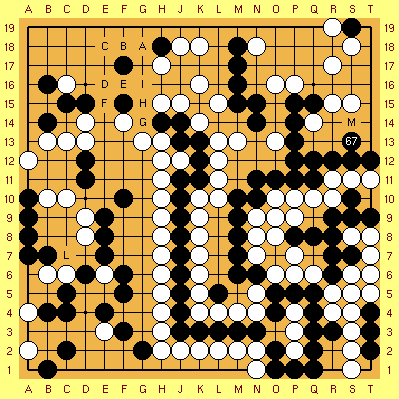 Dia. 10.1: "White's Choices After Black's Guzumi" |
In July 2010 we added the second edition of a supplement of approximately 750 variations after the "bad-shape"-move B 67 to this collection. Update 2011: Meanwhile, the number of variants rose to over 1,000. The first edition (March 2010) of variations after Black's Guzumi has been slightly extended, some mistakes have been corrected. Please be aware that the variations have been developed on amateur Kyu level only ! |

| |

The variation-tree after Black's Guzumi 67. |
|
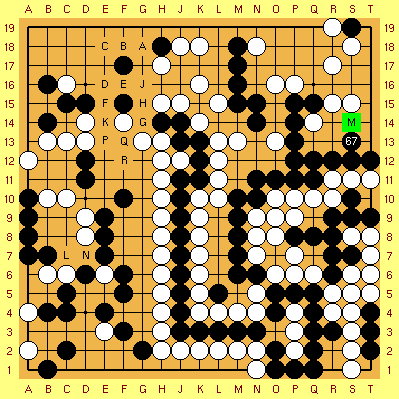 Dia. 11.41: "White's options after the Guzumi 67." |
In the meantime I have reviewed my variation-tree after Black's Guzumi at 67 several times; it now contains more than 1,000 variations. Current summary is as follows: Black wins by 2 points (score calculated without the second Throw-in). Most favourable for White is the path, which begins with M. It leads to a sequence, which is similar to the "official" Main Path (Crosscut sequence in the centre, Nakade sequence on the left, etc.). All other paths end comfortable for Black, the scores are within a range of approximately 7 points up. Thank you for your kind understanding that our new findings about the correct order of moves in the top right corner could not built into the variation tree, due to time and effort. |

| |
Our current solution. |
|
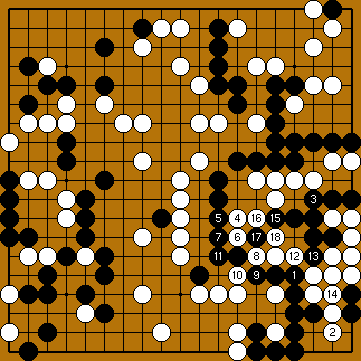 Dia. 11.61: "B 1 - W 18" |
|
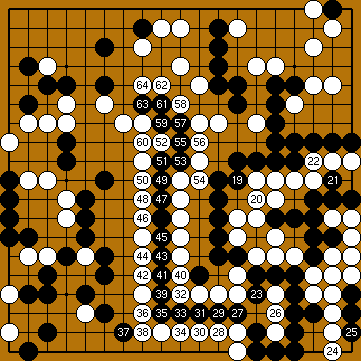 Dia. 11.62: "B 19 - W 64" |
Update: In his 2010 book "Research on Weiqi Fayanglun" Cheng Xiaoliu 6p used Black 19 to play the second Throw-in at 20. So we can assume our idea, which gains two points for Black in the Semeai variation, as professionally validated. |
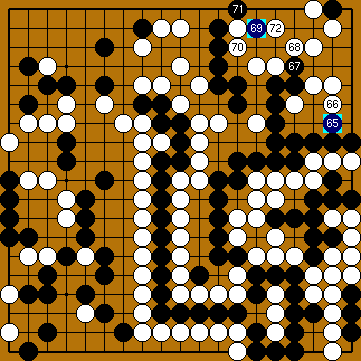 Dia. 11.63: "B 65 - W 72" |
B 65 = my Guzumi. B 69 = Harry's Hasami-Tsuke. Black's moves would be possible in the order of 67 - 69 - 71 - 65, too. |
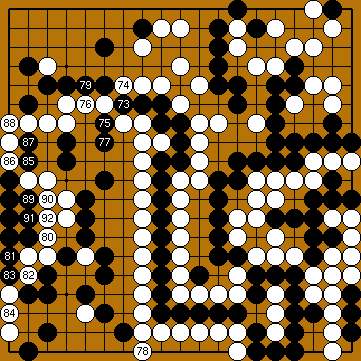 Dia. 11.64: "B 73 - W 92" |
|
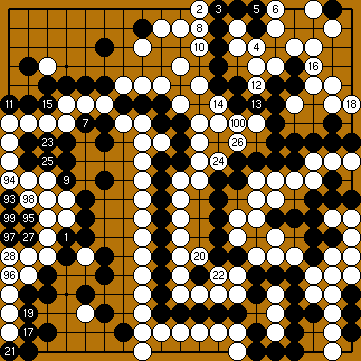 Dia. 11.65: "B 93 - W 128 (1 = 101)" |
|
 Dia. 11.66: "B 129 - W 136" |
|
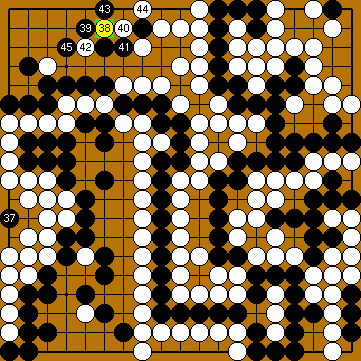 Dia. 11.67: "B 137 - B 145" |
W 138 = Yamada Shinji's Tsuke. |
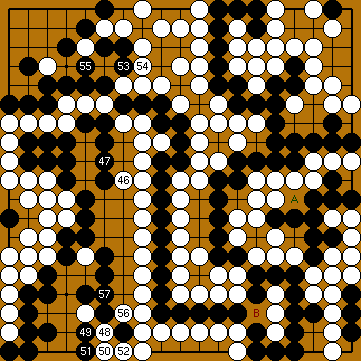 Dia. 11.68: "W 146 - B 157" |
A = White chooses the Semeai (correct). B = White captures Black's centre group (see below). |
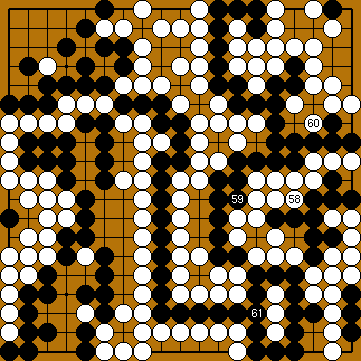 Dia. 11.69: "W 158 - B 161" |
|
 Dia. 11.70: "W 162 - W 166" |
|
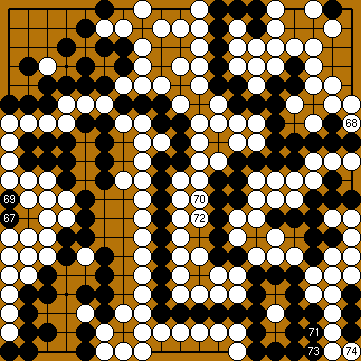 Dia. 11.71: "B 167 - W 174" |
|
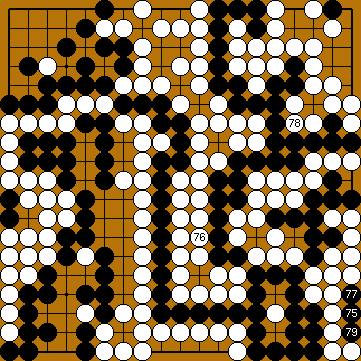 Dia. 11.72: "B 175 - B 179" |
|
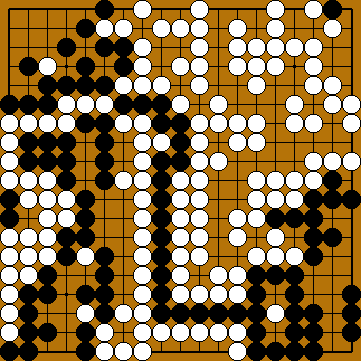 Dia. 11.73: "The End" |
|
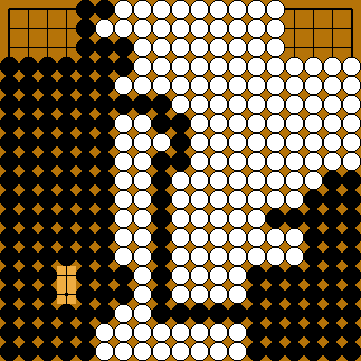 Dia. 11.74: "The Score" |
Black wins by 2 points. Update: If Black plays the second Throw-in with Black 19, he will be two points better in this variation, and win by 4 points. Please take notice that these results do not include Black's "lost" 71st stone (which is also assumed by Cheng Xiaolou 6p now). |

| |
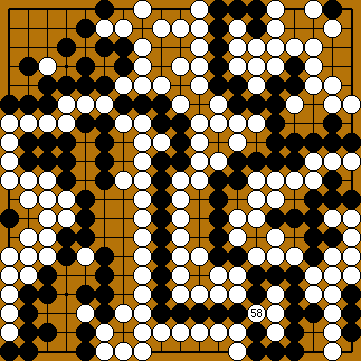 Dia. 11.75: "W 158" |
White captures Black's centre group. |
 Dia. 11.76: "B 159" |
|
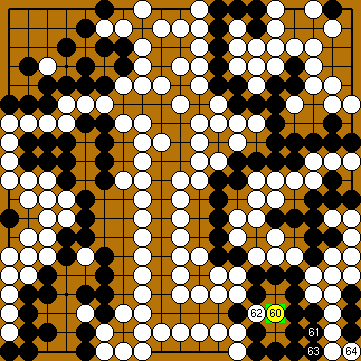 Dia. 11.77: "W 160 - W 166" |
W 160 = Joachim's Oki. |
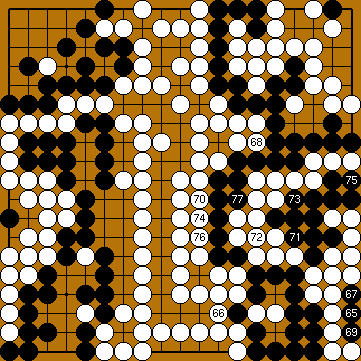 Dia. 11.78: "B 167 - B 177" |
|
 Dia. 11.79: "The End" |
|
 Dia. 11.80: "The Score" |
Black wins by 5 points. Update: If Black plays the second Throw-in with Black 19, he will be one point better in this variation, and win by 6 points. Please take notice that these results do not include Black's "lost" 71st stone (which is also assumed by Cheng Xiaolou 6p now). |

| |
A new type of Seki. |
|
 Dia. 11.101: "B 63 - W 100" |
B 63: Black choses another option to seperate White's groups in the centre. W 64: White cannot cut at 65, this would lead to a half-board-Seki. W 80: White penetrates into Black's corner. If she follows the Main Path with 98 instead, she will gain some points compared to it, but Black is still winning. Black continues by following the Main Path basically and after 100 it will be apparent, that White has one liberty more than usual in the top left and consequently wins the Semeai with the black group in the top right. B 91: It could be more interesting for Black to save his stones on the left with A. This will result in a Ko in the top left corner and finally White will win. |

| |
 Dia. 11.102: "W 64 - B 97" |
64: White cuts. 97: After this move it becomes evident that Black has more territory than White and will win. |
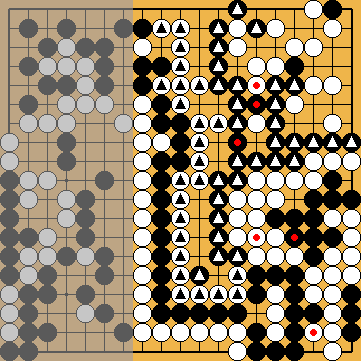 Dia. 11.103: "A new type of Seki." |
Fore the sake of better illustration, we have added a few stones (Ÿ), but refrained from showing the further occupation of liberties. On the right side a giant Seki was born. The white group in the centre is eyeless. Black's group above has indeed one eye; but in contrast to the general experience with "me ari me nashi" he will not be able to capture White's eyeless group below. |
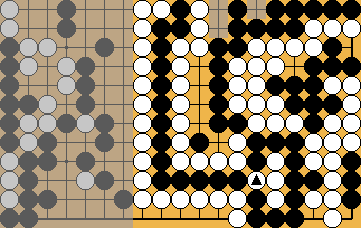 Dia. 11.104: "White captures Black's group." |
After White captured Black's centre group, ... |
 Dia. 11.105: "Black recaptures." |
... |
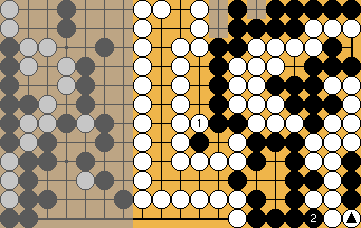 Dia. 11.106: "W 1 - B 2" |
... she can capture Black's top right group thereafter only, ... |
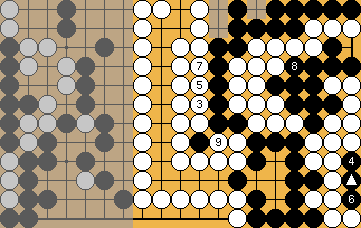 Dia. 11.107: "W 3 - W 9" |
...when this group has not more than five liberties, thus can be captured by 9. |
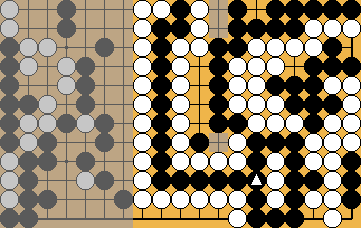 Dia. 11.108: "Black captures three white stones." |
On the other hand, Black can capture White's three stones at the bottom only, ... |
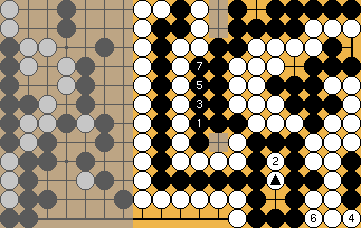 Dia. 11.109: "B 1 - B 7" |
... when White's centre group does not have more than four liberties and can by captured by 7. It follows that neither side must reduce the number of common liberties in the upper part of the Seki to four, so the Seki will remain stable. |

| |
 Dia. 11.111: "W 80 - W 94" |
W 80: White follows the Main Path. |
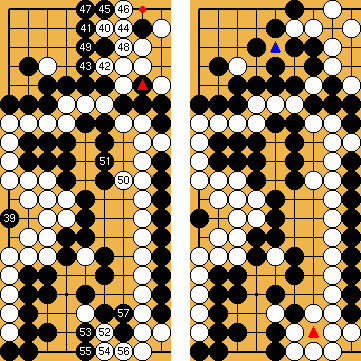 Dia. 11.112: "Comparison with our solution." |
This is the resulting endgame on the left side. At the top, White has one point more than usual (Ÿ), and Black has not captured one of White's stones (∆). At the bottom, Black could save one of his stones (∆). White gets a total advantage of 1 point. In the Semeai variation Black would win now by only 1 point instead of 2. In the Capture variation Black's lead would diminish from 5 points to 2, because White captures one more of Black's stones. Concluding, there would not be any room left for the existence of a 71st black stone anymore. |

| |
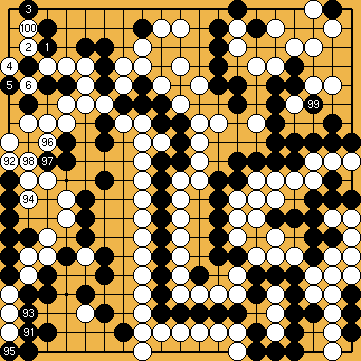 Dia. 11.121: "B 91 - W 106" |
B 91: Black saves his group on the left edge, forces White to make live for her group there with 97, and finally secures two eyes in the upper right with 99. W 100: White attacks Black's top left corner now and gets a Ko with 106 that Black cannot win. On the one hand, White has more Ko-threats than Black, on the other hand, Black is handicapped by the fact that he must return to the top left sooner or later to bring his partial group there to life. White will capture some Black stones and win. |
 Dia. 11.122: "B 107 - B 111" |
Perhaps the sequence will continue as follows. But please take this with a grain of salt, because Ko is my blind spot. |
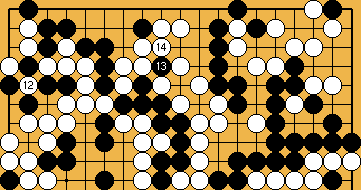 Dia. 11.123: "W 112 - B 114" |
... |
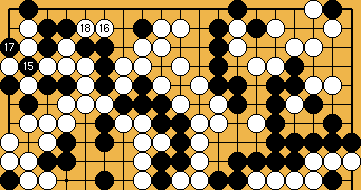 Dia. 11.124: "B 115 - W 118" |
Black has no Ko-threats anymore, which would result in the rescue of his centre group. So he can finish the Ko with 117. White captures some of Black's stones and gains enough to win by a few points. |

| |
Partial Validation Through Professional Chinese Research. |
|
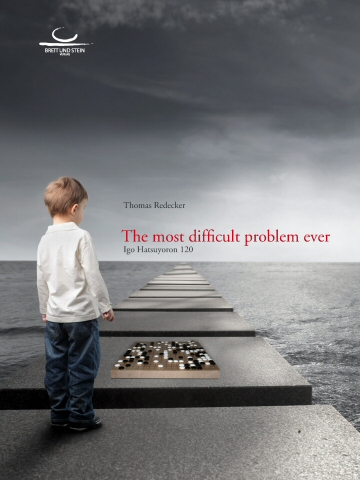 "The cover of our book" |
After our book "The most difficult problem ever: Igo Hatsuyoron 120" was in final proofs, we heard about a recently published book, "Research on Weiqi Fayanglun", by Cheng Xiaoliu 6p. As far as can see, for problem 120, the author's main results of interest to us are: He |
 Dia. 11.131: "Black lost a stone before the problem starts." |
- assumes that a black prisoner has been captured, before the problem starts (see here for details), |
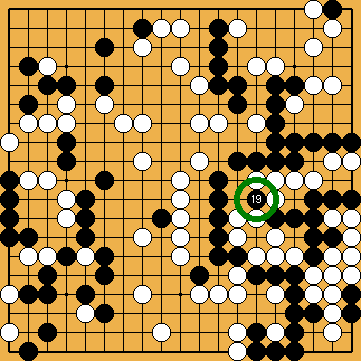 Dia. 11.132: "The second Throw-in." |
- uses the second Throw-in at lower right (see here for details), |
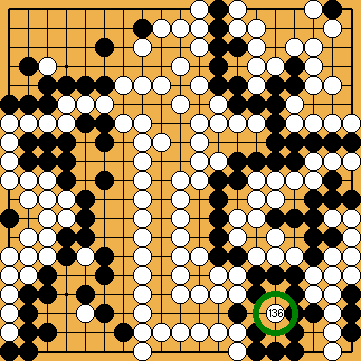 Dia. 11.133: "The decisive Oki." |
- uses the "late", decisive Oki at lower right (see here for details), |
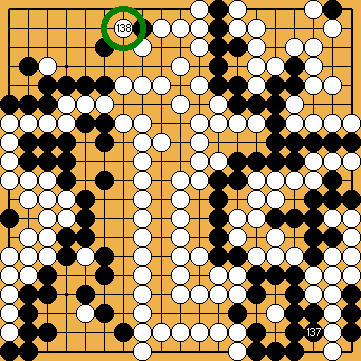 Dia. 11.134: "Beginning of the endgame on the left." |
- starts the endgame on the left side before further dissolving the Hanezeki, |
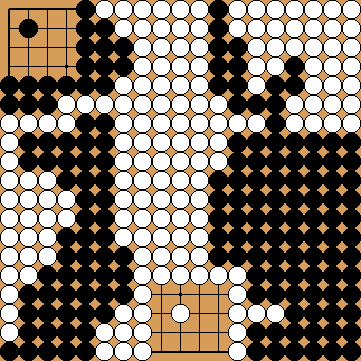 Dia. 11.135: "The final score." |
- gives the final result as Jigo, |
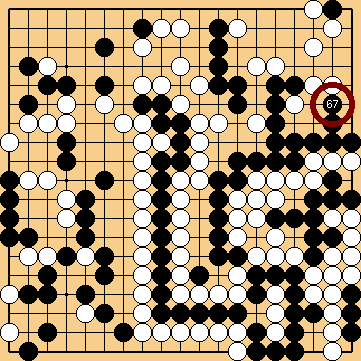 Dia. 11.136: "The Guzumi." |
- does not mention the Guzumi at top right (see here for details), |
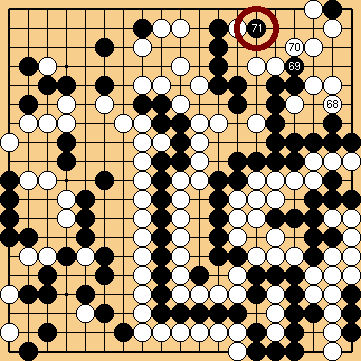 Dia. 11.137: "The Hasami-Tsuke." |
- does not mention the Hasami-Tsuke at top right (possible only in conjunction with the Guzumi, see here for details), |
 Dia. 11.138: "The Tsuke of Yamada Shinji 5p." |
- and does not mention the Tsuke at top left (see here for details). |

| |